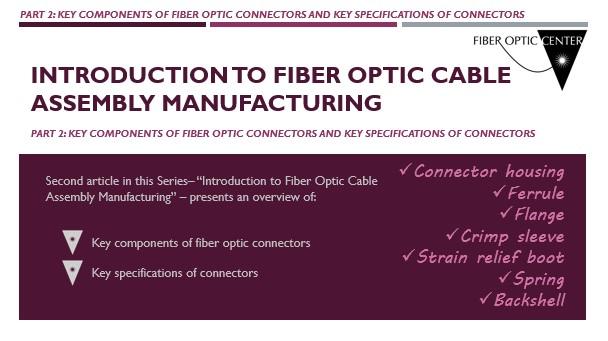Part 2: Introduction to Fiber Optic Cable Assembly Manufacturing
Key components of Fiber Optic Connectors and Key Specifications of Connectors
This article series introduces engineers and technicians to various aspects of the production process to manufacture world-class fiber optic cable assemblies (also known as fiber optic patch cords). In the cable assembly manufacturing process, it’s absolutely critical to assemble quality connectors that meet all relevant international standards for performance and long-term reliability.
In this educational article, we introduce you to key components of fiber optic connectors as well as key specifications of connectors.
Key components of fiber optic connectors
While there are many different styles of connectors for single-fiber and multi-fiber cable assemblies, all basically share a similar construction. This article presents a brief overview of these key components. (We encourage you to review the Fiber Optic Center Glossary to familiarize yourself with the wide range of industry terminology.)
Nearly all types of fiber optic connectors have the following components:
- Connector housing – Sometimes called the connector body or external housing, the housing is the largest portion of the connector and holds the ferrule. Typically, the housing is made of plastic. (Some connector styles are metal.) The housing enables you to mate your fiber optic cable assembly to an adapter or another connector.
- Ferrule – A critical component of the connector, the ferrule holds the optic fiber in place and aids in its alignment. The ferrule can be plastic, ceramic, metal, or glass and is usually cylindrical with a hole through the center.
- Flange – This material holds the ferrule in the housing. Some ferrules require flanges, and some don’t.
- Crimp sleeve – The crimp sleeve is made of soft, lightweight metal such as aluminum or brass. Using a crimping tool, the technician compresses the crimp sleeve to secure the strength members of the cable to the connector. This provides tensile strength, pullout strength, and strain relief. Some connector styles have a built-in crimp sleeve.
- Strain relief boot – Sometimes called the bend relief boot, this component offers side pull bend control to keep the fiber from bending more than 90 degrees and offers twist resistance. Every connector has a strain relief boot attached to the backshell to reduce mechanical stresses.
- Spring – Nearly all connectors are spring loaded. The spring maintains secure pressure against its mated, spring-loaded connector.
- Backshell – The primary job of the backshell is to allow the fiber to feed through the rear (wiring side) of the connector. Its secondary job is to provide a platform for the crimp sleeve. In some cases, the backshell is part of the flange.
Key specifications of connectors
The connector’s specifications dictate the quality of its performance and long-term reliability. That’s why it’s imperative to purchase high-quality connectors. Lower-quality connectors with lax tolerances can lead to optical performance issues such as high Insertion Loss, low Return Loss, and non-repeatable results. Lower-quality connectors can also invite a host of mechanical issues.
Whether you’re buying single mode connectors or multimode connectors, you want the best measurement tolerances possible for the following connector specifications:
- Ferrule hole diameter – The ferrule is arguably the most important component in a fiber optic connector. For minimum Insertion Loss, you should use the tightest-tolerance ferrule hole diameter available.
- Ferrule hole concentricity – The shape of the ferrule’s hole bore must be round. If not, you have ferrule hole eccentricity: an egg-shaped or oblong hole, which will not hold an optic fiber in perfect alignment and will degrade the performance of the connector. Ferrule hole concentricity is measured inside diameter to outside diameter (ID to OD).
- Ferrule hole to outside diameter (OD) – The hole in the ferrule must be perfectly centered. If not, the fiber it holds cannot be properly centered and aligned. This is why it’s important to purchase ferrules with exacting tolerances.
At Fiber Optic Center, Inc., we encourage our customers to purchase quality connectors that offer the tightest tolerances for ferrule hole diameter, ferrule hole concentricity, and ferrule hole to outside diameter. When your fiber optic cable assembly house uses connectors that meet stringent measurements tolerances, you are positioned to build world-class fiber optic cable assemblies that deliver performance and long-term reliability.
Additional resources to continue your education:
- View Interconnect Technical Solution Content
- View the Glossary, Acronyms, Military Specifications for Connectors
- Q&A Resource: email technical questions to AskFOC@focenter.com

EDITOR’S NOTE: This is the second article in an ongoing series, “Introduction to Fiber Optic Cable Assembly Manufacturing.”:
- Part 1: Components of the Fiber Optic Patch Cord and Optic Fiber Geometry
- Part 2: Key Components of Fiber Optic Connectors and Key Specifications of Connectors
- Part 3: The 101 on Connector Types
- Part 4: Establishing Internal Industry Product Standards for Fiber Optic Assemblies



